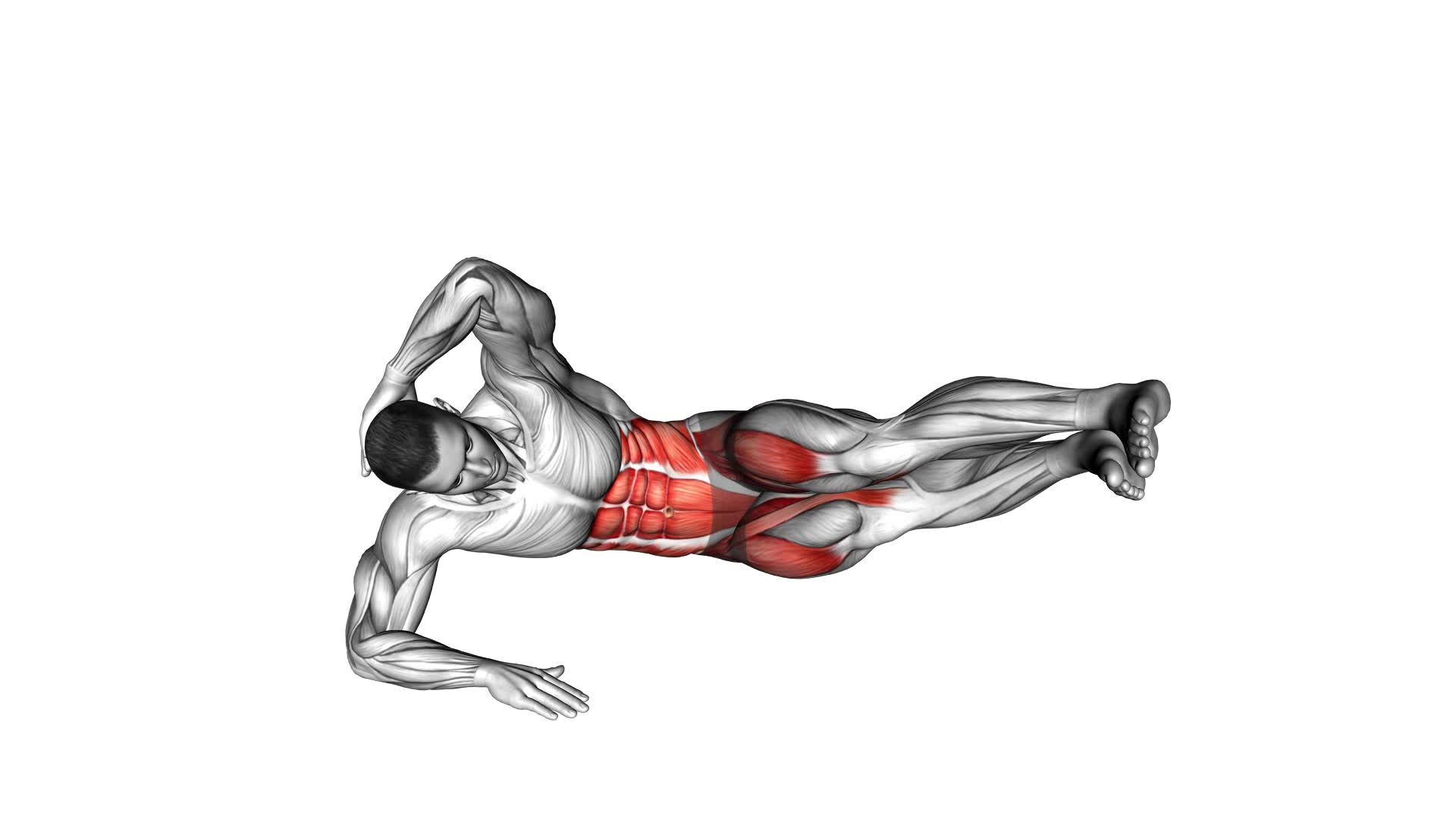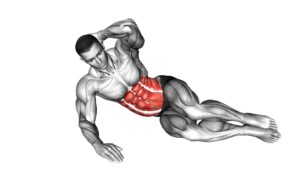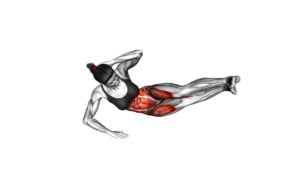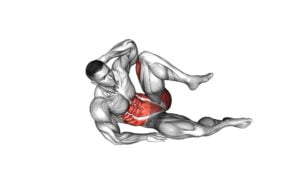Oblique V-up on Floor – Video Exercise Guide & Tips

Get ready to tone and strengthen your obliques with the Oblique V-up on the floor. This video exercise guide and tips will show you the proper form, common mistakes to avoid, and modifications for different fitness levels.
Watch This Exercise Video
Maximize your results with these expert tips and a sample workout routine. Whether you're a beginner or a fitness pro, this exercise will help you achieve a stronger and more sculpted core.
Let's get started!
Key Takeaways
- Oblique V-ups target and strengthen the oblique muscles for a more defined waistline.
- Proper form and technique are crucial to avoid strain and injury.
- Variations and progressions can be added to challenge the core muscles and improve strength and stability.
- Modifications are available for different fitness levels, and consistency is key for significant results.
Benefits of Oblique V-up on Floor
To maximize your core strength and target your oblique muscles, the Oblique V-up on the floor offers a highly effective exercise option. This exercise specifically focuses on your oblique muscles, which are located on the sides of your abdomen. By performing Oblique V-ups on the floor, you can strengthen and tone these muscles, helping to create a more defined waistline and improve your overall core stability.
There are various variations of the Oblique V-up that you can incorporate into your ab routine. One option is to perform the exercise with your legs straight and raised off the ground, reaching your opposite hand towards your toes as you lift your upper body off the floor. Another variation involves bending your knees and placing your feet on the ground, then twisting your torso to touch your opposite knee with your elbow.
Incorporating Oblique V-ups into your ab routine can provide numerous benefits. Not only will you be targeting your oblique muscles, but you'll also be engaging your entire core, including your rectus abdominis and transverse abdominis. This exercise can improve your overall core strength, enhance your balance, and even help with stability in everyday movements. Additionally, by adding variations to the Oblique V-up, you can continuously challenge your muscles and prevent boredom in your workout routine.
Proper Form for Oblique V-up on Floor
To perform the Oblique V-up on the floor with proper form, position yourself on your side, resting your weight on your forearm and keeping your legs extended straight. Here's how to execute this exercise correctly:
- Start by lying on your side with your legs fully extended.
- Place your bottom forearm on the ground, keeping it perpendicular to your body.
- Engage your core and lift your legs off the ground, raising them as high as possible.
- At the same time, lift your torso off the ground, reaching your top arm towards your legs.
- Hold the contracted position for a moment, then slowly lower your legs and torso back to the starting position.
- Repeat the movement for the desired number of repetitions, then switch to the other side.
To add variety and challenge to your oblique V-up routine, consider incorporating these variations and progressions:
- Perform the exercise with ankle weights or a medicine ball for added resistance.
- Try doing the exercise on an incline bench or stability ball to engage your stabilizing muscles.
- Increase the tempo or add a pause at the top of the movement to increase intensity.
By incorporating these oblique V-up variations and progressions, you can continuously challenge your core muscles and improve your strength and stability.
Now, let's move on to the next section and discuss common mistakes to avoid when performing this exercise.
Common Mistakes to Avoid
When performing the oblique V-up on the floor, it's important to avoid common mistakes that can lead to improper form and potential dangers.
One mistake to avoid isn't fully engaging your core muscles, which can result in a less effective workout and potential injury.
Another mistake is overarching your lower back, which can put excess strain on the spine.
Improper Form Dangers
Are you aware of the potential dangers of improper form while performing the Oblique V-up on the floor exercise? It's crucial to understand the risks associated with incorrect technique and the importance of proper form.
Here are some dangers to be aware of:
- Strained muscles: Executing the exercise with improper form can put excessive strain on your muscles, leading to sprains, strains, or even muscle tears.
- Lower back pain: Failing to engage your core and relying solely on the momentum of your legs can cause unnecessary stress on your lower back, resulting in pain or injury.
- Neck strain: Lifting your upper body too forcefully or using your neck muscles instead of your abdominals can strain your neck and result in discomfort or injury.
To avoid these dangers, ensure you maintain proper alignment, engage your core, and perform the exercise with controlled movements.
Lack of Core Engagement
Failing to engage your core properly can lead to a lack of effectiveness and potential injury while performing the Oblique V-up on the floor exercise. Your core strength plays a crucial role in stabilizing your body and maintaining proper form throughout the movement. Without proper engagement, you may find yourself relying too much on your hip flexors or lower back, which can lead to strain and discomfort.
To ensure you're engaging your core effectively, focus on maintaining a strong plank position during the exercise. Plank variations, such as the forearm plank or side plank, can help you develop the necessary core strength and stability. By incorporating these exercises into your routine, you'll enhance your core engagement and maximize the benefits of the Oblique V-up on the floor exercise.
Now let's discuss the next common mistake to avoid – overarching the lower back.
Overarching the Lower Back
To avoid overarching your lower back during the Oblique V-up on the floor exercise, make sure to maintain a neutral spine position. Overarching can put unnecessary strain on your lower back and detract from the effectiveness of the exercise. Here are three common mistakes to avoid when performing this exercise:
- Rounding your shoulders: Keep your shoulders relaxed and avoid rounding them forward, as this can contribute to overarching your lower back.
- Lifting your legs too high: While it may be tempting to lift your legs as high as possible, doing so can cause your lower back to arch excessively. Focus on lifting your legs to a comfortable height while maintaining proper form.
- Neglecting core engagement: Engaging your core muscles is crucial for maintaining a neutral spine position. Remember to activate your core throughout the exercise to support your lower back.
Modifications for Different Fitness Levels
Now let's talk about modifications for different fitness levels.
Whether you're a beginner, intermediate, or advanced, there are options to suit your needs.
Beginners can start with easier modifications, intermediates can make adjustments to challenge themselves, and advanced individuals can try more advanced variations to push their limits.
Beginner-Friendly Modifications
For beginners looking to modify the Oblique V-up on the floor exercise, there are several options available to make it more accessible for different fitness levels.
Here are some beginner modifications and proper form guidelines to help you get started:
- Start by bending your knees and keeping your feet flat on the floor to reduce the difficulty of the exercise.
- Instead of lifting both legs simultaneously, try lifting one leg at a time while keeping the other foot on the ground for added stability.
- If you find it challenging to lift your upper body off the floor, place your hands behind your head for support.
By incorporating these modifications and following proper form guidelines, beginners can gradually build strength and improve their technique.
Once you feel comfortable with these modifications, you can move on to intermediate level adjustments to further challenge yourself.
Intermediate Level Adjustments
After incorporating the beginner modifications mentioned earlier, you can further challenge yourself and adjust the Oblique V-up on the floor exercise based on your fitness level.
For intermediate modifications, you can try adding ankle weights or holding a dumbbell in your top hand while performing the exercise. These additional weights will increase the resistance and make the exercise more challenging for your oblique muscles.
Another option is to increase the number of repetitions or sets you perform. This will help to further fatigue your muscles and promote strength and endurance gains.
For advanced variations, you can try performing the exercise on an unstable surface, such as a stability ball or a Bosu ball. This will engage your core muscles even more and require greater stability and balance.
Remember to always listen to your body and progress at a pace that's suitable for you.
Advanced Variations for Pros
To further challenge yourself in the Oblique V-up on the floor exercise, advanced variations are available for pros of different fitness levels. These variations offer a higher level of difficulty and can help you take your oblique workout to the next level. Here are some advanced variations to consider:
- Weighted Oblique V-up: Hold a dumbbell or a medicine ball in your hands while performing the V-up. This added resistance will increase the intensity of the exercise and provide a greater challenge for your oblique muscles.
- Single-leg Oblique V-up: Lift one leg off the floor while performing the V-up. This variation increases the demand on your core stability and engages your obliques even more.
- Plyometric Oblique V-up: Instead of a controlled movement, explosively lift your upper body and legs off the floor in a quick and powerful motion. This plyometric variation adds an element of power and agility to the exercise.
When performing these advanced variations, it's important to maintain proper form and technique to prevent injury. Take note of the pros and cons of each variation and choose the one that suits your fitness level and goals.
Tips to Maximize Results
Get the most out of your oblique V-up on the floor exercise with these effective tips. Maximizing your oblique V-up results requires proper technique and focus. Here are some techniques that can help you achieve better results.
Firstly, make sure to engage your core muscles throughout the exercise. This won't only target your obliques but also strengthen your entire core. Keep your abs tight and your back straight to maintain proper form.
Secondly, focus on quality over quantity. It's better to perform fewer reps with correct form than to rush through the exercise with poor technique. Slow and controlled movements will activate your obliques more effectively.
Additionally, incorporate variations into your routine. By changing the angle or adding weights, you can challenge your obliques in different ways and stimulate muscle growth. Some effective variations include bicycle crunches, Russian twists, and side plank dips.
Furthermore, consistency is key. Aim to perform oblique V-ups at least two to three times a week to see significant results. Remember to give yourself rest days to allow your muscles to recover and grow.
Sample Oblique V-up Workout Routine
To begin your oblique V-up workout routine, start with a warm-up to prepare your muscles for the exercises ahead. This could include jogging in place, jumping jacks, or dynamic stretches. Once you're warmed up, you can move on to the oblique V-up exercise.
Here is a sample workout routine to help you get started:
- Perform 3 sets of 10-12 reps on each side of the oblique V-up exercise.
- Rest for 30-60 seconds between each set.
After completing the oblique V-up exercise, incorporate other oblique exercises to further challenge your muscles. Some advanced oblique exercises you can try include:
- Side Plank with Hip Dips: Start in a side plank position and lower your hip towards the floor, then raise it back up. Aim for 10-12 reps on each side.
- Russian Twists: Sit on the floor with your knees bent and feet flat. Hold a weight or medicine ball in front of your chest and twist your torso from side to side. Aim for 15-20 reps.
- Bicycle Crunches: Lie on your back with your hands behind your head. Bring your opposite elbow to meet your knee as you extend your other leg. Alternate sides for 15-20 reps.
Remember to listen to your body and adjust the intensity and number of reps according to your fitness level. Don't forget to cool down and stretch after your workout to prevent muscle soreness.
Frequently Asked Questions
How Many Calories Does the Oblique V-Up on the Floor Burn?
The oblique v-up on the floor is a great exercise for strengthening your core. It targets your oblique muscles, which are located on the sides of your abdomen. By incorporating oblique v-ups into your workout routine, you can burn calories and build a stronger core.
This exercise involves lying on your back and lifting your legs and upper body off the ground, reaching your hands towards your feet. It's a challenging move that can help you achieve your fitness goals.
Can the Oblique V-Up on the Floor Help in Reducing Belly Fat?
Yes, the oblique V-up on the floor can help in reducing belly fat. It targets the oblique muscles, which are located on the sides of your abdomen.
However, it's important to note that spot reduction isn't possible, so incorporating other exercises that work the entire body is essential for overall fat loss.
Additionally, diet plays a significant role in reducing belly fat, so make sure to maintain a balanced and healthy eating plan.
Is It Necessary to Warm-Up Before Performing the Oblique V-Up on the Floor?
Before performing the oblique v-up on the floor, it's important to warm up. Incorporating warm-up exercises can help prepare your body for the workout, increase blood flow, and reduce the risk of injury. Additionally, warming up can improve your overall performance during the exercise.
It's also beneficial to know that there are modifications and variations of the oblique v-up on the floor for different fitness levels. So, take the time to warm up and explore different options to suit your needs.
Can the Oblique V-Up on the Floor Be Done by Beginners?
Yes, beginners can do the oblique v-up on the floor. It's a great exercise for strengthening your oblique muscles. To make it easier, you can modify the movement by bending your knees or using a foam pad for support.
Common mistakes in oblique v-ups include using momentum instead of engaging your core, and lifting your entire upper body instead of just your shoulders.
Remember to start with proper form and gradually increase intensity as you get stronger.
How Often Should the Oblique V-Up on the Floor Be Performed to See Results?
To see results from the oblique v-up on the floor, you need to perform it frequently. The frequency of your oblique v-up workouts will directly impact their effectiveness. Consistency is key here.
Aim to do this exercise at least three times a week for best results. By incorporating the oblique v-up into your regular workout routine, you'll start to notice improvements in your core strength and definition.
Conclusion
In conclusion, the oblique V-up on the floor is a highly effective exercise for targeting and strengthening the oblique muscles.
By maintaining proper form and avoiding common mistakes, individuals can maximize their results and avoid injury.
This exercise can be modified to accommodate different fitness levels, making it accessible to individuals of all abilities.
By incorporating the oblique V-up into a regular workout routine, individuals can achieve toned and defined oblique muscles.

Author
Years ago, the spark of my life’s passion ignited in my mind the moment I stepped into the local gym for the first time. The inaugural bead of perspiration, the initial endeavor, the very first surge of endorphins, and a sense of pride that washed over me post-workout marked the beginning of my deep-seated interest in strength sports, fitness, and sports nutrition. This very curiosity blossomed rapidly into a profound fascination, propelling me to earn a Master’s degree in Physical Education from the Academy of Physical Education in Krakow, followed by a Sports Manager diploma from the Jagiellonian University. My journey of growth led me to gain more specialized qualifications, such as being a certified personal trainer with a focus on sports dietetics, a lifeguard, and an instructor for wellness and corrective gymnastics. Theoretical knowledge paired seamlessly with practical experience, reinforcing my belief that the transformation of individuals under my guidance was also a reflection of my personal growth. This belief holds true even today. Each day, I strive to push the boundaries and explore new realms. These realms gently elevate me to greater heights. The unique combination of passion for my field and the continuous quest for growth fuels my drive to break new ground.



